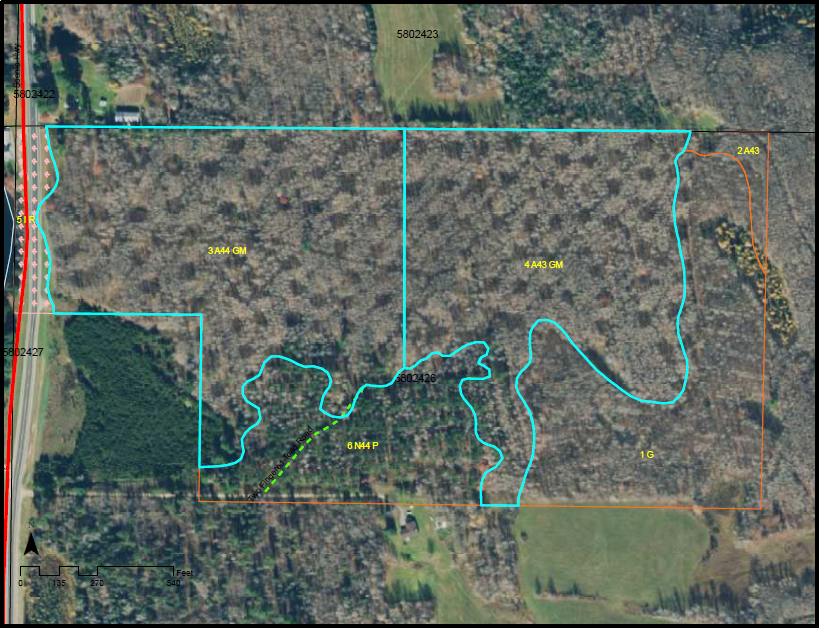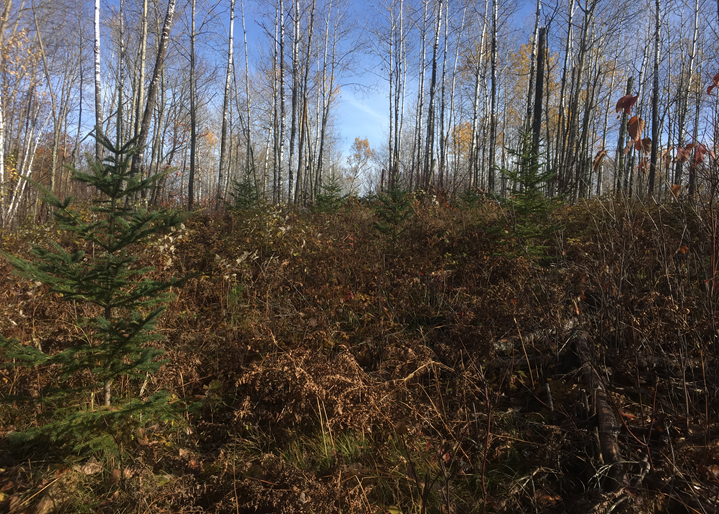Overview
The stand was a 37 year-old aspen stand with a small bur oak component. The goal of the stand management was to use patch clearcuts to create gaps, which would then be replanted with softwoods to transition the stand into a 2-aged, mixed wood composition. The remaining aspen can then be harvested in the future and the harvested areas regenerated.
Silviculture Objective(s)
Use patch clearcuts to create small ¼-acre gaps in the stand.
Pre-treatment stand description and condition
Pre-treatment species composition:
Prior to treatment, the area was a 37 year-old aspen stand in good condition, with a small component of bur oak. The shrub layer was dominated by hazel, with components of both red-osier dogwood and blackberry.
Plant Community: MHn44 - Northern wet-mesic boreal hardwood
Pre-treatment forest health issues:
No pre-treatment health issues, stand was in good condition.

Figure 1: Soil composition of the stand
Silviculture Prescription
Use patch clearcuts to create small ¼-acre gaps in the stand. Gaps will cover approximately 1/4th of the site, and be planted with containerized stock of primarily white spruce, with small amounts of white pine and red pine. Four years after planting, release the conifers via brush saw to improve growth and competition.
What actually happened during the treatment
Summer harvest in 2010 took place, using a cut-to-length harvesting system. A main skid trail was established, with harvest lanes at least 100 feet apart herring-boned from the main skid trail. Along the harvest lanes, “pearls” of 100 foot diameter were clearcut with centers 200 feet apart from each other. Bur oaks are reserved for seed and hard mast production. The cut produced about 20 cords per acre of cut stand, which averages to 5 cords per acre across the entire stand. The gaps were then replanted with containerized white spruce, red pine, and white pine the following spring in 2011.
Post-treatment assessment
Three years post-replanting the survival rate for conifers was 78%, with a density of 350/acre for white spruce and 1400/acre for aspen regeneration. Three years after planting, a brush saw release was implemented, and all woody vegetation within 4 feet of a planted conifer was removed. Current stand condition is a young two-aged stand with a 45 year-old aspen cohort and ¼ of the stand is a 7 year-old aspen/spruce mix as of 2017. There is a minor component of bur oak that is older, but the majority of the stand is aspen.
Plans for future treatments
The stand is planned to be harvested again around 2022 by using a coppice to remove the 45 year-old aspen component. This will hopefully result in strong regeneration and a mixed-species stand that will have more structural diversity than the original aspen stand.
Summary / lessons learned / additional thoughts
This stand is being managed with both a plan for economic as well as ecological value. By underplanting with spruce, the diversity and therefore ecological value of the land can be increased, while also ensuring that spruce is available for harvest in the future. Having spruce ready to harvest in tandem with the aspen makes sense as it is a vital component of creating paper products. This is one way in which foresters are able to meet multiple goals creatively, and manage for long-term forest health and production.
While the prescription was overall successful in establishing conifers, survival was slightly lower than desired. Future attempts should experiment with larger gap sizes and planting within the un-cut matrix to maximize planted seedling survival and reduce need for brush saw release.
